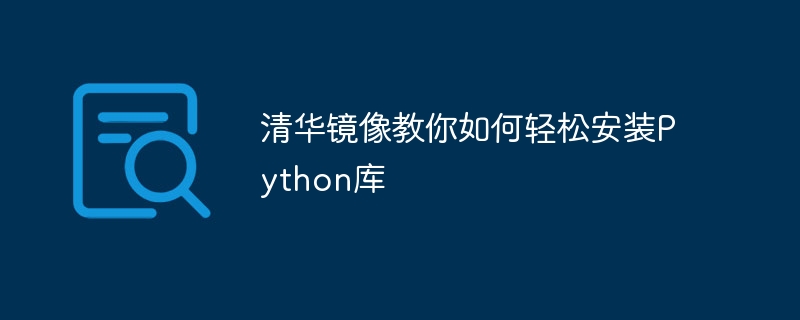

Tsinghua Mirror teaches you how to easily install Python libraries, requiring specific code examples
As a popular programming language, Python has a rich collection of libraries that can Help us complete various tasks more efficiently. In order to use these libraries properly, we need to install them into our Python environment. However, sometimes we may encounter the problem of being unable to download and install the library normally due to network reasons. At this time, Tsinghua Mirror, as a platform that provides high-speed download services, can help us easily solve this problem.
Tsinghua Mirror Source is a domestic open source software mirror station. It provides download services for a large number of open source software including Python libraries. For the convenience of users, Tsinghua Image Source provides a simple command line tool - pip, which is used to install the Python library. Next, let us introduce in detail how to use the Tsinghua mirror source to install the Python library.
First, we need to open the Python environment in the terminal. In Windows systems, you can use the Win R shortcut key to open the run window, enter cmd and press Enter to open the command prompt window. In Mac or Linux systems, you can directly enter python in the terminal and press Enter to enter the Python environment.
Next, we need to install the Python library using the pip command. The general format is pip install package_name, where package_name is the name of the library that needs to be installed. But in order to use the Tsinghua mirror source, we need to add the -i parameter after the pip install command to specify the address of the mirror source. The address of the Tsinghua mirror source is https://pypi.tuna.tsinghua.edu.cn/simple/. Therefore, the command format to install the Python library is pip install package_name -i https://pypi.tuna.tsinghua.edu.cn/simple/.
For example, if we want to install the numpy library, we can enter the following command in the command prompt window:
pip install numpy -i https://pypi.tuna.tsinghua.edu.cn/simple/
After executing the command, pipThe numpy library will be automatically downloaded and installed from the Tsinghua mirror source. The entire process may take some time, depending on the network environment and the size of the library. After the installation is complete, we can use the numpy library in the Python environment.
Similarly, we can use the Tsinghua mirror source to install other Python libraries. Just replace numpy in the above command with the name of other libraries.
In addition to using the command line tool pip, we can also use pip in the Python file to install the library. In Python code, we can call the subprocess module to execute command line commands. The following is a sample code:
import subprocess
def install_package(package_name):
command = "pip install {} -i https://pypi.tuna.tsinghua.edu.cn/simple/".format(package_name)
process = subprocess.Popen(command.split(), stdout=subprocess.PIPE)
output, error = process.communicate()
if error:
print("安装失败:", error)
else:
print("安装成功!")
if __name__ == "__main__":
package_name = input("请输入需要安装的库的名称:")
install_package(package_name)The above code can be run in the terminal and specify the name of the library that needs to be installed through user input. Then, the code will call the pip command to install the library and output the installation results.
In summary, Tsinghua mirror source provides us with a convenient and efficient way to install Python libraries. By using the pip command and specifying the address of the Tsinghua mirror source, we can easily download and install various Python libraries. This is a good solution for users who cannot download the installation library normally due to network reasons. I hope that the content provided in this article can help readers better use Python and deepen their understanding and application of Tsinghua mirror sources.
The above is the detailed content of Learn how to easily install Python libraries: Tsinghua Mirror Guide. For more information, please follow other related articles on the PHP Chinese website!




